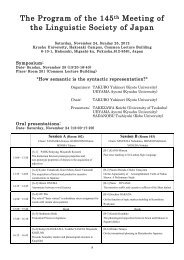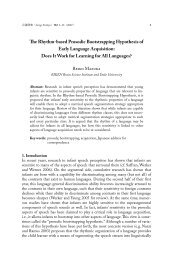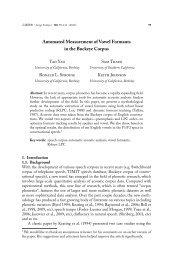第117åæ¥æ¬è§£åå¦ä¼ç·ä¼ã»å ¨å½å¦è¡éä¼ è¬æ¼ããã°ã©ã ã»æé²é PDF ...
第117åæ¥æ¬è§£åå¦ä¼ç·ä¼ã»å ¨å½å¦è¡éä¼ è¬æ¼ããã°ã©ã ã»æé²é PDF ...
第117åæ¥æ¬è§£åå¦ä¼ç·ä¼ã»å ¨å½å¦è¡éä¼ è¬æ¼ããã°ã©ã ã»æé²é PDF ...
Create successful ePaper yourself
Turn your PDF publications into a flip-book with our unique Google optimized e-Paper software.
106<br />
117 <br />
OEAMV<br />
Homera regulates the activityinduced remodeling of synaptic<br />
structures in cultured hippocampal neurons<br />
1 2 1 1 1 <br />
1 1 1 1<br />
1<br />
2 <br />
<br />
Homer1a LTP seizure <br />
PSD95 Homer1cFactin <br />
<br />
1h <br />
<br />
4h8hshRNA Homer1a <br />
knock down <br />
Homer1a <br />
OEAMV<br />
PIPKα regulates neuronal microtubule depolymerase KIFA and<br />
suppresses elongation of axon branches<br />
1,2,3 1,2 1 4 4 <br />
1<br />
1<br />
2 3 <br />
4 <br />
Neuronal morphology is regulated by the cytoskeleton. Kinesin superfamily<br />
protein 2A KIF2A depolymerizes microtubules MTs at growth cones and<br />
regulates axon pathfinding. The factors regulating KIF2A in neurite development<br />
remain elusive. Here, using immunoprecipitation with an antibody specific to<br />
KIF2A, we identified phosphatidylinositol 4phosphate 5kinase PIPK as a<br />
candidate membrane protein that regulates the activity of KIF2A. Yeast two<br />
hybrid and biochemical assays demonstrated direct binding between KIF2A and<br />
PIPKα. Partial colocalization of the clusters of punctate signals for these two<br />
molecules was detected by confocal microscopy and photoactivated localization<br />
microscopy. Additionally, the MTdepolymerizing activity of KIF2A was<br />
enhanced in the presence of PIPKα in vitro and in vivo, suggesting a novel PIPK<br />
mediated mechanism controlling MT dynamics in neurite remodeling.<br />
OFAMIII<br />
SNAP <br />
<br />
<br />
<br />
<br />
<br />
<br />
SNARE SNARE <br />
SNAP23 SNAP23 tSNARE<br />
<br />
<br />
<br />
SNAP23 SNAP23<br />
<br />
SNAP23 <br />
<br />
CreloxP <br />
NestinCre <br />
2<br />
<br />
SNAP23 <br />
<br />
OFAMIII<br />
<br />
<br />
<br />
<br />
<br />
<br />
<br />
<br />
GM130 <br />
GBF1 <br />
<br />
810 <br />
<br />
<br />
<br />
GM130 GBF1 <br />
GM130 GBF1 <br />
<br />
<br />
<br />
<br />
OFAMIII<br />
<br />
1 1 2<br />
1<br />
2 <br />
<br />
<br />
<br />
7 30 <br />
15 <br />
20 <br />
<br />
15 <br />
δ2 <br />
15 <br />
δ2 20 <br />
δ2 <br />
<br />
α2 15 <br />
20 <br />
<br />
<br />
OFAMIII<br />
Input pathway and target cell typedependent regulation of synaptic<br />
AMPAR subunits in hippocampal CA region<br />
1 2 3 3 3 <br />
1<br />
1<br />
Department of Anatomy, Hokkaido University Graduate School of Medicine,<br />
2<br />
Department of Anatomy, Kitasato University School of Medicine, 3 Department of<br />
Cellular Neurobiology, Brain Research Institute, Niigata University<br />
The AMPAtype glutamate receptor AMPAR is a tetramer of GluA subunits<br />
GluA1A4. Subunit combinations and contents of synaptic AMPAR are the<br />
major determinants of physiological properties of glutamatergic synapses. In<br />
the present study, the composition of synaptic AMPAR was investigated using<br />
subunitspecific antibodies and riboprobes in the mouse hippocampal CA1.<br />
Multiplelabeling in situ hybridization revealed that the subunit combination<br />
in pyramidal cells was GluA1, GluA2, and GluA3. Interneurons were high for<br />
GluA1, GluA3, and GluA4, and almost negative for GluA2. Exceptionally,<br />
parvalbumin PVpositive cells expressed all four subunits at high levels.<br />
Quantitative immunogold analyses revealed that labeling densities in Schaffer<br />
collateralCA1 pyramidal cell synapses were much higher than those in perforant<br />
path synapses, showing input pathwaydependent distribution. Synapses on PV<br />
positive cells displayed 23 times higher labeling densities for all four subunits<br />
than those on PVnegative interneurons. These results indicate that the subunit<br />
combinations and content of synaptic AMPAR are differently regulated by input<br />
pathway and target cell typedependent manners.







